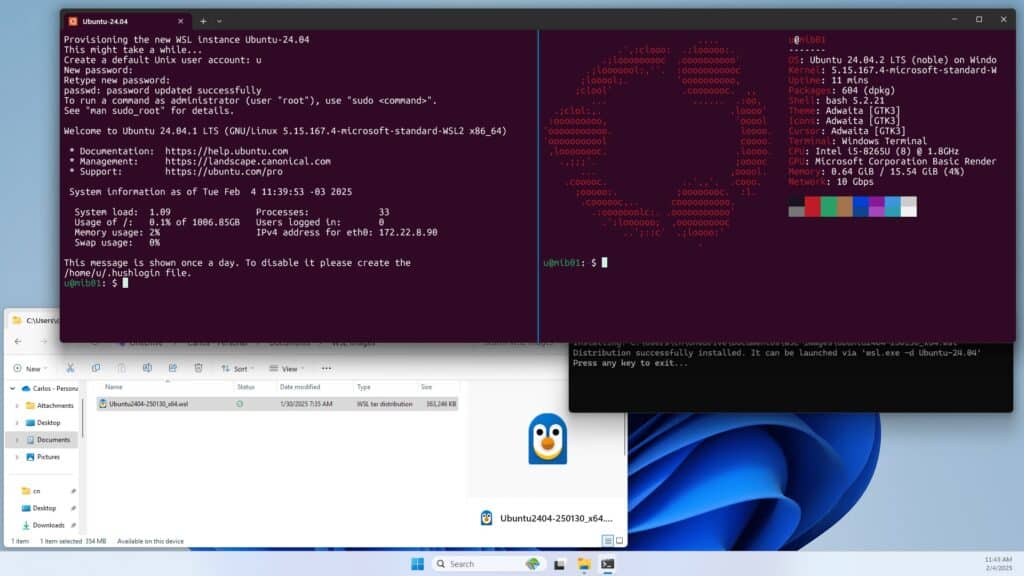In a landmark move for open source development and cross-platform interoperability, Microsoft has officially open sourced the Windows Subsystem for Linux (WSL). The announcement, published on the Windows blog, signifies the culmination of nearly a decade of engineering and community advocacy, finally answering the first-ever GitHub issue filed on the Microsoft/WSL repo: “Will this be open source?”
As of today, developers and enthusiasts can browse, build, and contribute to WSL directly on GitHub, with the project now fully accessible under an open-source license.
WSL’s Modular Architecture Now Transparent
WSL enables Windows users to run full Linux distributions natively, without dual booting or traditional virtual machines. Its architecture is hybrid, involving components that operate both within Windows and inside a lightweight Linux VM (in WSL 2). With the open-source release, Microsoft provides visibility into the following key areas:
- Command-line tools such as
wsl.exe,wslconfig.exe, andwslg.exe, which serve as user entry points. wslservice.exe, responsible for launching the WSL VM, mounting shared drives, and managing distro sessions.- Linux-side services, including initialization, networking (
gns), and port forwarding tools (localhost). - The Plan9 server, used for sharing files between Windows and Linux environments.
Notably, certain components—like the lxcore.sys kernel driver for WSL 1 and the p9rdr.sys drivers used for the \\wsl.localhost file system redirection—remain closed-source due to their deep integration with the Windows kernel.
From Built-In to Modular: A Journey Toward Independence
WSL began its life as a built-in feature in the Windows 10 Anniversary Update (2016), using lxcore.sys to translate Linux syscalls directly in the Windows kernel—a revolutionary idea at the time. However, for full Linux compatibility, Microsoft transitioned to a VM-based approach in WSL 2, unveiled in 2019.
To decouple WSL’s development from the Windows release cycle, Microsoft moved WSL into a standalone package in 2021, releasing it on the Microsoft Store. By version 1.0.0 in 2022, WSL supported both Windows 10 and 11, with new features like systemd, GUI apps (via WSLg), GPU acceleration, and networking enhancements.
With version 2.5.7 now available, WSL includes modern innovations like mirrored networking, DNS tunneling, proxy/firewall support, and Session 0 integration—bringing it closer than ever to native Linux behavior on Windows.
Why Open Source Now?
According to Microsoft engineer Pierre Boulay, this decision was both practical and symbolic. WSL has long been shaped by a passionate developer community, which, despite the absence of source code, contributed bug reports, workarounds, tooling, and integrations. Open-sourcing WSL reflects Microsoft’s renewed commitment to transparency and collaboration.
“Even without access to the source code, contributors helped make WSL what it is today,” Boulay writes. “Now, they can take it even further.”
What This Means for Developers
With the WSL codebase now public, developers can:
- Explore how WSL works under the hood
- Submit pull requests to add features or fix bugs
- Customize builds to suit enterprise or research environments
- Audit the software for compliance and security
This move also paves the way for tighter integration between WSL and the broader open source ecosystem, potentially accelerating innovation in Linux-on-Windows workflows for AI, DevOps, containerization, and secure development.
A New Chapter for Cross-Platform Computing
Microsoft’s decision to open source WSL is more than a symbolic gesture—it’s a strategic shift toward community-driven development and open hybrid environments. With Linux usage on Windows at an all-time high among developers, system administrators, and AI practitioners, this transparency will likely lead to faster iteration, deeper trust, and broader adoption.
As of today, users can visit https://wsl.dev to learn about WSL’s architecture, and head to the Microsoft/WSL GitHub repository to explore or contribute to its future.
TL;DR: The Windows Subsystem for Linux is now open source. Microsoft invites the global developer community to shape the future of cross-platform development—one commit at a time.

